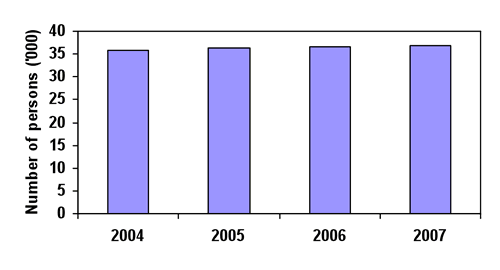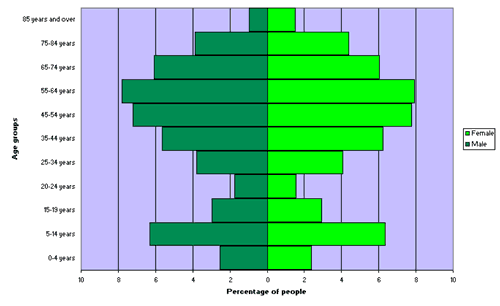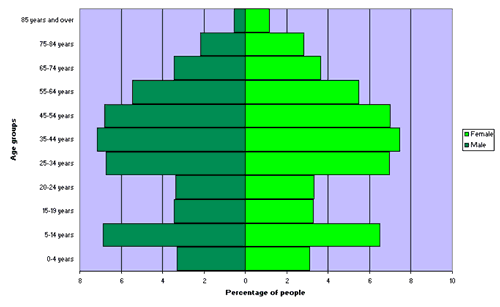Eurobodalla
Indicator: Population
Results for this indicator are also available for [an error occurred while processing this directive]
What the results tell us for Eurobodalla
Eurobodalla Shire Council area continued to experience a small increase in population growth. According to the 2006 Census there were 36,595 residents in the Shire with an estimated 36,771 in 2007. Since the end of the previous State of the Environment Reporting period, the population of the Shire is estimated to have increased by 1.1% or 960 persons.
Compared with New South Wales (NSW) as a whole, Eurobodalla has a higher aged population, a slightly higher indigenous population and a small increase in the proportion of persons born overseas which concords with a gradual increase for the State. Along with many other jurisdictions in Australia, Eurobodalla Council will need to consider the impacts of an ageing population on its economy, and infrastructure.
The composition of households has continued the trend noted in the 2004 report with a further reduction in the number of households comprising couples with children and a consequent increase in couples without children and also lone person households. Eurobodalla’s -Social Plan is committed to addressing these issues.
Population is growing in number and ageing slowly
The population in Eurobodalla Shire was 36,595 at the 2006 Census (Table 1). Based on the latest available ABS figures (2008), it can be seen that the population rose by 960 since 2004. This represents an annual average rate of growth of 1.1% for the period, compared with 0.7% average for the Australian Capital Region for the period, and 0.8% for New South Wales as a whole. Compared with all local government areas across the state, the Shire ranked 84 out of 149 for the fastest growth and 72 out of 152 for the largest growth. Figure 1 illustrates the population for the years 2004 to 2007, showing the annual estimated residential population at 30 June for each year.
| 2004 | 2005 | 2006 | 2007 | Population Change2004-2007 |
|---|---|---|---|---|
| 35,811 | 36,230 | 36,595 | 36,771 | 960 (1.1 % p.a.) |
See About the data for Australian Bureau of Statistics comments on years 2001-2007; Source: Australian Bureau of Statistics Catalogue No. 3218.0 (2008)
Figure 1. Population growth, Eurobodalla Shire, 2004 to 2007

Source: Australian Bureau of Statistics Catalogue No. 3218.0 (2008)
Since the 2004 report the Shire has experienced a relatively small growth in population but this needs to be seen in the context of the age profile. As stated in the previous report, there are fewer youth and more aged people although the variations are small. This trend has continued through the current reporting period. The percentage of ‘under 15’s’ in the population dropped by 2.6% in the period 1996 to 2006 compared with a drop of 1.7% from 1986 to 1996. The ‘middle’ age group decreased by 2.5% (1996-2006) as opposed to the increase of 0.2% in the earlier 10 year period. On the other hand the more senior group increased by 1.2% compared with the 1.9% increase during the earlier period. The median age as at 2006 was 47 years in Eurobodalla Shire compared with the state median of 37 years. In 2001 the median was 44 with 35 for the state, and in 1996, 42 and 34 years respectively. Percentages and figures are illustrated in Table 2.
These trends are similar to those evident in other Shires in the Region although with slightly less variance and will have resultant impacts on the Shire’s healthcare, social, economic and transport needs into the future.
| Age | 1996 | 2001 | 2006 | |||
|---|---|---|---|---|---|---|
| No. | % | No. | % | No. | % | |
| <15 years | 6,431 | 21.1 | 6,370 | 19.2 | 6,081 | 17.5 |
| 15–64 years | 17,398 | 57.1 | 19,414 | 58.6 | 20,655 | 59.6 |
| 65+ years | 6,618 | 21.7 | 7,353 | 22.2 | 7,924 | 22.9 |
| Totals | 30,447 | 100 | 33,137 | 100 | 34,660 | 100 |
See About the data for Australian Bureau of Statistics comments on this table; Source: Australian Bureau of Statistics Census 2006 Time Series Profile Catalogue No. 2003.0
Ethnicity and diversity
Gender
Eurobodalla Shire’s population as at the 2006 Census was split 48.9% male and 51.06% female. Compared with the gender distribution for New South Wales (49.3% males to 50.7% females), the Shire’s population has a slight bias toward females. See Figures 2 and 3 for a comparison of the gender and age distribution for the Shire and New South Wales respectively.
Figure 2. Age and sex distribution, Eurobodalla Shire, 2006

Source of data: Australian Bureau of Statistics Census 2006 Time Series Profile Catalogue No. 2003.0
Figure 3. Age and sex distribution, New South Wales, 2006

Source of data: Australian Bureau of Statistics Census 2006 Time Series Profile Catalogue No. 2003.0
Origins
In 2006, 81.9% of Eurobodalla Shire’s non-Indigenous residents were born in Australia, compared with 82.4% in 2001 and 83.1% in 1996 (Table 3). By comparison, New South Wales has experienced a drop of about 1% between Censuses (1996, 2001, 2006). The proportion of indigenous population for the Shire has increased since the last report to 4.5% from 4.2% in 2001 and 3.7% in 1996. This remains a higher percentage compared with the rest of the State (2.2%) in 2006. The ‘Born overseas’ group has increased by 0.2% to 13.6% in the 2006 Census from 13.4% in 2001 compared with the gradual increase (0.65%) in proportion experienced by New South Wales as a whole.
| Origin | 1996 Census | 2001 Census | 2006 Census | |||
|---|---|---|---|---|---|---|
| No. | % | No. | % | No. | % | |
| Indigenous persons | 1,134 | 3.7 | 1,378 | 4.2 | 1,537 | 4.5 |
| Born in Australia | 25,137 | 83.1 | 26,766 | 82.4 | 28,096 | 81.9 |
| Born overseas (a) | 3,996 | 13.2 | 4,360 | 13.4 | 4,653 | 13.6 |
| Total | 30,267 | 100 | 32,504 | 100 | 34,286 | 100 |
See About the data for notes on (a); Source: Australian Bureau of Statistics Census 2006 Time Series Profile Catalogue No. 2003.0
Households and family type
In 2006, 67.4% of Shire residents lived in one-family households consisting of 21.5% couples with children, 34.5% couples with no children and 10.7% were one-parent families. About 25.4% of the population consisted of lone person households. (Table 4). The group with the most significant percentage drop was the ‘Couple family with children’ group, having fallen by 3.5% since the 1996 Census whereas the percentage of households occupied by ‘Couple family without children’ rose by 1.1%. Similar trends are evident in New South Wales as a whole.
| Household composition | 1996 Census | 2001 Census | 2006 Census | |||
|---|---|---|---|---|---|---|
| Dwellings | % | Dwellings | % | Dwellings | % | |
| One family household: | ||||||
| Couple family with children | 3,066 | 25.0 | 3,089 | 22.5 | 3,132 | 21.5 |
| Couple family without children | 4,047 | 33.0 | 4,591 | 33.4 | 5,021 | 34.5 |
| One parent family | 1,047 | 8.5 | 1,319 | 9.6 | 1,550 | 10.7 |
| Other family | 74 | 0.6 | 86 | 0.6 | 95 | 0.7 |
| Total | 8,234 | 67.1 | 9,085 | 66.1 | 9,798 | 67.4 |
| Miscellaneous households: | ||||||
| Group household | 299 | 2.4 | 303 | 2.2 | 358 | 2.5 |
| Lone person household | 2,935 | 23.9 | 3,433 | 25.0 | 3,687 | 25.4 |
| Other household (c) | 800 | 6.5 | 924 | 6.7 | 692 | 4.8 |
| Total | 12,268 | 100 | 13,745 | 100 | 14,535 | 100 |
For notes on (a), (b) and (c) see About the data; Source: Australian Bureau of Statistics Census 2006 Time Series Profile, Catalogue No. 2003.0
Where people are working and what they are earning
The retail trade sector continues as the highest employer as at the 2006 census at 16.9% having risen 1% since 2001. This mirrors the State as a whole as the leading employer at 11.1%.
The Health care and social assistance sector has experienced a 1.3% increase in employment levels from the 2001 to 2006 census (10.4% to 11.7% respectively) and is now the second highest industry of employment.
The accommodation and food services sector has fallen 0.7% from the 2001 Census but is now the 3rd largest employer behind Health care and social services.
Employment in the construction sector has also increased to 10.4% in 2006 from 9.2% in 2001. However employment in the manufacturing sector has experienced a 1% decrease which is the largest increase over the 5 years (2001 to 2006). Conversely, for the State as a whole employment in this sector has fallen 1.4% to 9.6% in 2006 compared with 2001.
| Industry of employment (a) | 1996 Census | 2001 Census | 2006 Census | |||
|---|---|---|---|---|---|---|
| Persons | % | Persons | % | Persons | % | |
| Agriculture, forestry & fishing | 502 | 5.6 | 474 | 4.6 | 402 | 3.3 |
| Mining | 21 | 0.2 | 13 | 0.1 | 16 | 0.1 |
| Manufacturing | 655 | 7.2 | 705 | 6.8 | 711 | 5.8 |
| Electricity, gas, water & waste services | 83 | 0.9 | 97 | 0.9 | 152 | 1.2 |
| Construction | 750 | 8.3 | 948 | 9.2 | 1,268 | 10.4 |
| Wholesale trade | 330 | 3.6 | 353 | 3.4 | 243 | 2.0 |
| Retail trade | 1,329 | 14.7 | 1,642 | 15.9 | 2,056 | 16.9 |
| Accommodation & food services | 1,061 | 11.8 | 1,275 | 12.3 | 1,407 | 11.5 |
| Transport, postal & warehousing | 263 | 2.9 | 343 | 3.3 | 402 | 3.3 |
| Information media & telecommunications | 146 | 1.6 | 138 | 1.3 | 149 | 1.2 |
| Financial & insurance services | 212 | 2.3 | 200 | 1.9 | 204 | 1.7 |
| Rental, hiring & real estate services | 170 | 1.9 | 197 | 1.9 | 248 | 2.0 |
| Professional, scientific & technical services | 267 | 3.0 | 330 | 3.2 | 479 | 3.9 |
| Administrative & support services | 230 | 2.6 | 292 | 2.8 | 402 | 3.3 |
| Public administration & safety | 528 | 5.8 | 622 | 6.0 | 734 | 6.0 |
| Education & training | 680 | 7.5 | 809 | 7.8 | 910 | 7.5 |
| Health care & social assistance | 991 | 11.0 | 1,075 | 10.4 | 1,422 | 11.7 |
| Arts & recreation services | 139 | 1.5 | 189 | 1.8 | 214 | 1.8 |
| Other services | 413 | 4.6 | 420 | 4.1 | 472 | 3.9 |
| Inadequately described/Not stated | 259 | 2.9 | 221 | 2.1 | 298 | 2.4 |
| Total | 9,029 | 100 | 10,343 | 100 | 12,189 | 100 |
For notes on (a) see About the data; Source: Australian Bureau of Statistics Census 2006 Time Series Profile, Catalogue No. 2003.0
About the data
Data for this indicator were sourced from the Australian Bureau of Statistics
Data for Table 1— Estimated Residential Population Australian Bureau of Statistics Catalogue No. 3218.0. Years 2004-2006 are preliminary rebased figures, whereas 2007 figures are preliminary. The figure for 2004 was only preliminary at the time of writing the 2004 State of the Environment Report, therefore it has now been revised. As explained in the Extract from Explanatory Notes, Australian Bureau of Statistics—Catalogue No. 3218.0 (2008), ‘To meet the conflicting demands for accuracy and timeliness there are several versions of sub-state/territory population estimates. Preliminary estimates are normally available nine months after the reference date (i.e. March), revised estimates twelve months later and rebased and final estimates after the following census.' Estimated population is preliminary rebased for 2002 to 2006, based on results of the 2006 Census of Population and Housing, and preliminary for 2007. At the time of writing, final 2006 Census-based estimates for 2002 to 2006, together with the first revision of 2007 were not yet available.
Data for Table 2 – Selected Person Characteristics: Australian Bureau of Statistics, Time Series Profile (T01), Catalogue No. 2003.0, Commonwealth of Australia, 2006.
Data for Table 3 – Selected Person Characteristics: Australian Bureau of Statistics, Time Series Profile (T01), Catalogue No. 2003.0, Commonwealth of Australia, 2006, (a) Includes 'Australian External Territories', 'Inadequately described', 'At sea' and 'Not elsewhere classified'.
Data for Table 4 —Dwelling Structure by Household Composition and Family Composition: Australian Bureau of Statistics, Time Series Profile (T14), Catalogue No. 2003.0, Commonwealth of Australia, 2006 (a) The 'Household Composition' variable replaced 'Household Type', which was used in 1996 and 2001; (b) The 'Family Composition' variable replaced 'Family Type', which was used in 1996 and 2001; (c) Comprises 'Visitors only' and 'Other not classifiable' households.
Data for Table 5 — Industry types in Eurobodalla Shire: Australian Bureau of Statistics, Time Series Profile (T25), Catalogue No. 2003.0, Commonwealth of Australia, 2006. (a) Industry of employment was coded to the 2006 Australian and New Zealand Standard Industrial Classification (ANZSIC) edition. This has replaced the 1993 ANZSIC edition.
References
Australian Bureau of Statistics (2007) Regional Population Growth, Australia, 1996 to 2006, Catalogue No. 3218.0 — ‘Estimated Residential Population—30 June ', Commonwealth of Australia, http://www.abs.gov.au/
Australian Bureau of Statistics (2008) Regional Population Growth, Australia, 2006-07, Catalogue No. 3218.0 — ‘Population Estimates by Local Government Area, 2001 to 2007 — 30 June', Commonwealth of Australia, http://www.abs.gov.au/
Australian Bureau of Statistics (2006) Time Series Profile, Catalogue No. 2003.0, Commonwealth of Australia, http://www.abs.gov.au/
